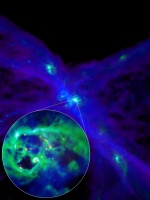 Divx/avi Animation (40 MB)
Divx/avi Animation (40 MB)

This is James Wadsley's gallery of images of the astrophysical simulations we are running at McMaster University using the computing resources of the SHARCNET collaboration ( www.sharcnet.ca). Some simulations shown were run elsewhere.
The software we are using is the parallel SPH tree-code "Gasoline" developed at the University of Washington, "N-body Shop" by James Wadsley, Joachim Stadel and Tom Quinn. This paper describes Gasoline.
Click here for the full movie: AVI Movie
. Below is an animated gif of a late stage of the simulation.
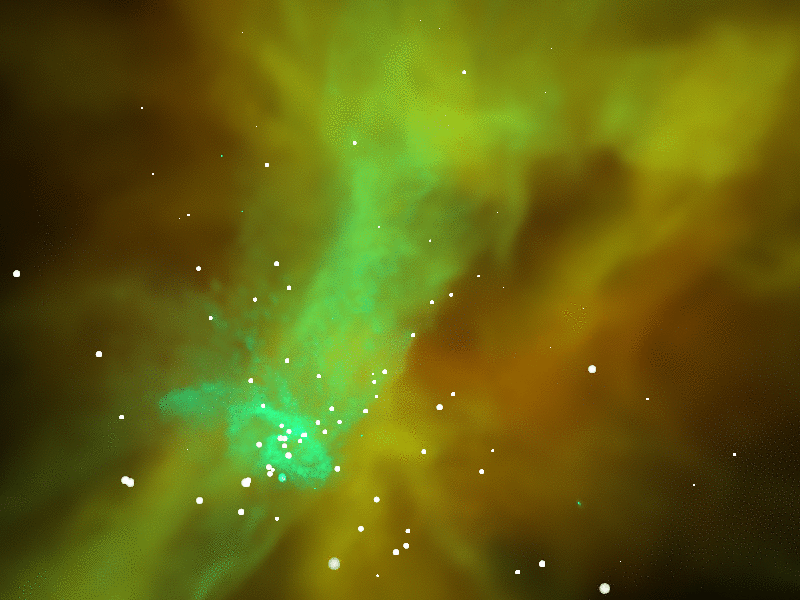
Young star (proto-stellar disk) collisions and fragmentation to form Brown Dwarfs :
Visualizations of simulations completed by Sijing Shen for her Masters
Thesis (May 2006)
Click for MPEG Movie (5.9 MB)
Click here for a detailed description of the
movies, images and associated research.
 START: Two proto-stellar disks |
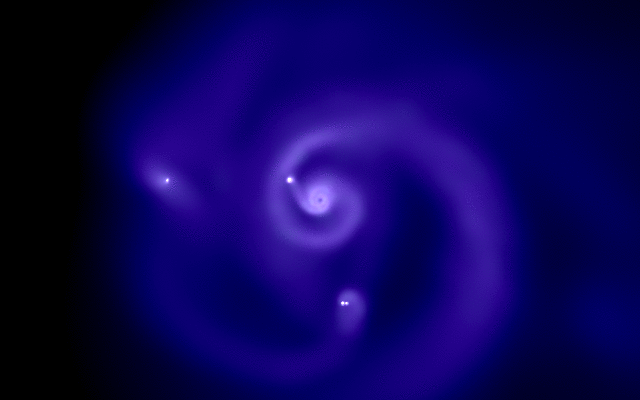 END: Brown Dwarfs in orbit (Binary is bottom, centre) |
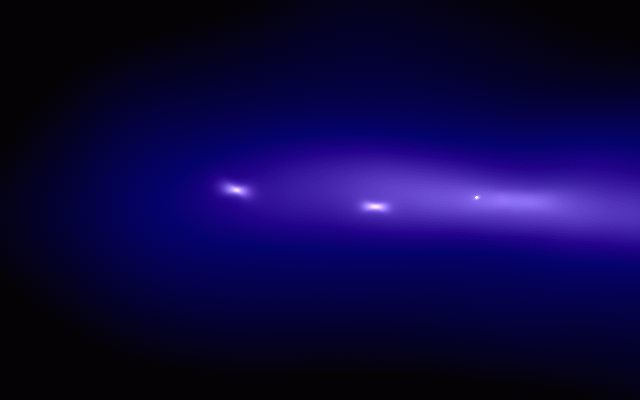 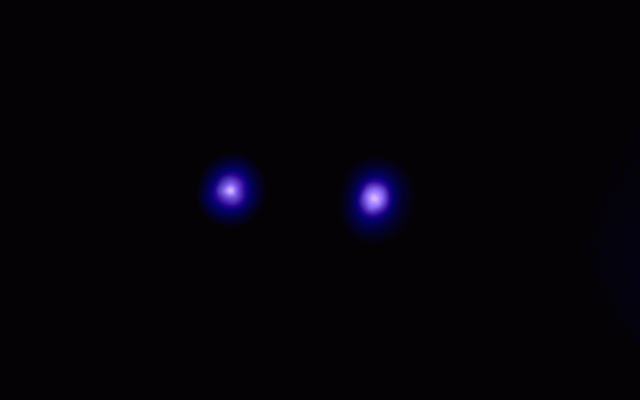 Brown Dwarf Binary (Zoom in, edge and face-on) |
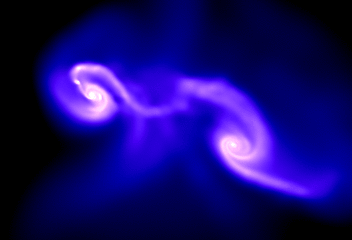
| Gas surface density [Animation: ON , OFF, new window] |
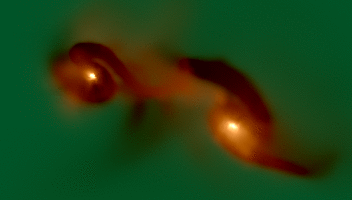
|
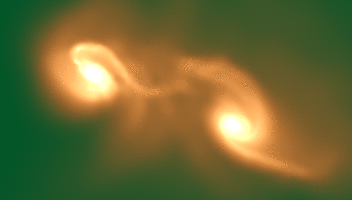
|
| Simulated Optical Image [Animation: ON, OFF, new window] | Simulated Infrared Image |
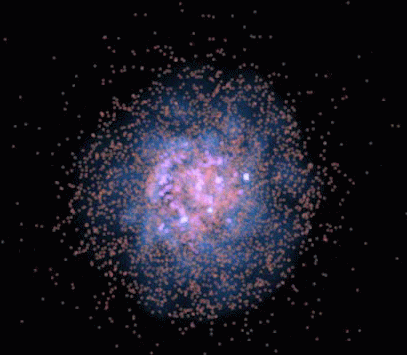 Fabio Governato, James Wadsley 2005
Fabio Governato, James Wadsley 2005
This is an isolated galaxy test run. The movie frames
use realistic colours and brightnesses for the stars
that fade rapidly from blue to red over time. The greenish material represents
the gas from which the stars are being formed.
"Forming Giant Planets via Fragmentation of Protoplanetary
Disks"
Lucio Mayer, Tom Quinn, James Wadsley and Joachim Stadel
Published in SCIENCE, appeared on Nov 29th, 2002.
These Gasoline simulations are the first to demonstrate that framentation
of a gas disk around a young star can produce giant gas planets.
The planets have properties
similar to the observed large extra-solar planets. Please read the
science article for full details or see the McMaster press release .
The simulations were performed at the Pittsburgh Supercomputing
Center and CINECA (Italy).
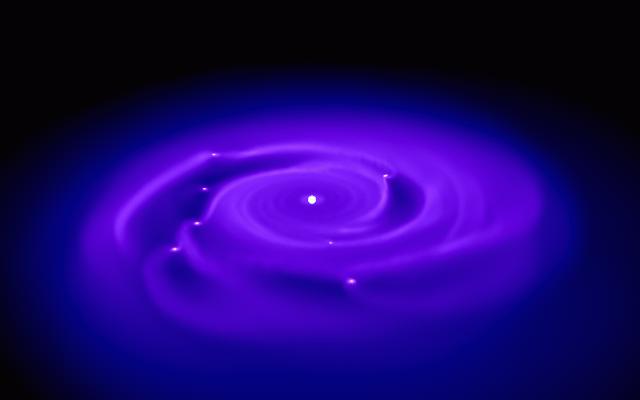
|
Click here for the MOVIE .
This MPEG movie (1.2 MB) covers the evolution from 120 to 300 years
in a case that is marginally unstable. Several
Jupiter-like planets are formed.
The image [click it for full size] shows the disk at 350 years. |
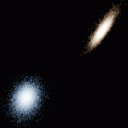
| This is a standard equal mass galaxy merger from Mihos and Hernquist (1996, ApJ) with 100K particles (stars and dark matter). This is similar to the upcoming Andromeda - Milky Way collision. |
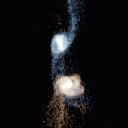 Shorter Movie, 2.8 MB
Shorter Movie, 2.8 MB
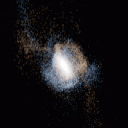 Longer Movie, 30 MB
Longer Movie, 30 MB
James W. Wadsley (McMaster University)
Marcelo I. Ruetalo (CITA)
J. Richard Bond (CITA)
Carlo R. Contaldi (CITA)
Hugh M. P. Couchman (McMaster University)
Joachim Stadel (University of Victoria)
Thomas R. Quinn (University of Washington, Seattle)
Michael D. Gladders (University of Toronto)
The 270 million particle simulation shown was presented by James Wadsley at the Canadian Astronomical Society (CASCA) meeting 2002 in Penticton, BC (May 11-14).

|

|

|
| Poster image 3600x3600 GIF, 16 MB. | Poster image 600x600 GIF, 0.3 MB. | Full Poster with caption, title PDF, 33 MB |
Caption
The image shows gas density on a periodically extended 2.8 by 2.6
billion light year sheet, 290 million light years thick (displaying
each part of the volume once). Each bright point is a large galaxy or
group of galaxies evolved within a Lambda cold dark matter cosmology
to the current time. We are studying the galaxy clusters making up
the beautiful large scale structures through their predicted X-rays,
gravitational lensing and Sunyaev-Zel'dovich effect.
The simulation was run by James Wadsley at McMaster University on Idra, a 112 processor Compaq AlphaServer acquired through SHARCNET. It was run using the Gasoline parallel SPH and N-Body code (Wadsley, Stadel and Quinn) with 512 cubed 17 billion solar mass dark matter particles and 512 cubed gas particles. Gasoline has sustained over 50 GFLOPS on Idra. The Sharc-Net consortium is an ORDCF/CFI project to boost high performance parallel computing in Ontario
The movies may play more cleanly if you download the .mpg first and then play them (eg. mpeg_play). They look best at 16 bpp. I suggest trying a framerate of 10 fps and double size if your screen height is 768 or more pixels (eg. mpeg_play -framerate 10 -dither color2).
The simulation was performed by James Wadsley on Idra, the McMaster SHARCNET 114 Processor Compaq Alphaserver, and used 80 GB of memory and 100,000 node hours of CPU (11 years of computing for a single machine).
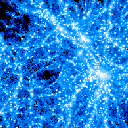 Mosaic of Entire Box at Redshift 0 (Current Time) (contiguous 400x400x40 Mpc slices) showing Density
Mosaic of Entire Box at Redshift 0 (Current Time) (contiguous 400x400x40 Mpc slices) showing Density
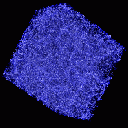 Movie of Gas Density (98 MB Mpeg)
Movie of Gas Density (98 MB Mpeg)
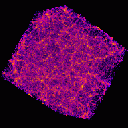 Movie of Gas Temperature (94 MB Mpeg)
Movie of Gas Temperature (94 MB Mpeg)
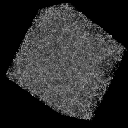 Movie of Total Matter Density (high contours) (85 MB Mpeg)
Movie of Total Matter Density (high contours) (85 MB Mpeg)
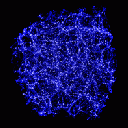 Movie of Gas Density (86 MB Mpeg)
Movie of Gas Density (86 MB Mpeg)
 Movie of Gas Temperature (106 MB Mpeg)
Movie of Gas Temperature (106 MB Mpeg)
This Website is maintained by James Wadsley , Associate Professor in the McMaster University Physics and Astronomy Department.